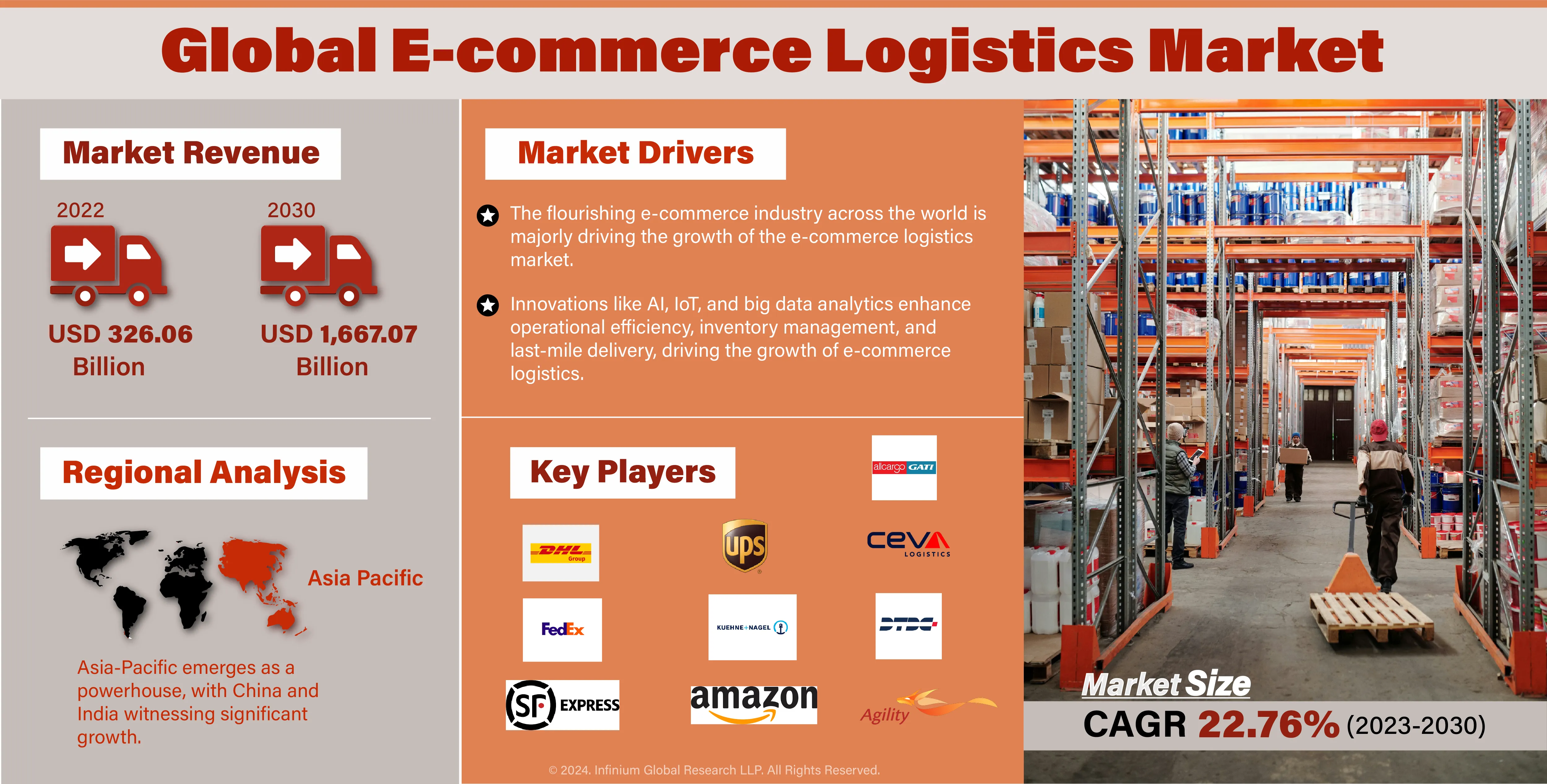E-commerce Logistics Market (Operational Area - Domestic, and International; Service Type - Transportation, and Warehousing; Product - Electronics Products, Automotive Products, Home Furnishing Products, and Other Products): Global Industry Analysis, Trends, Size, Share and Forecasts to 2030
A recent report published by Infinium Global Research on e-commerce logistics market provides in-depth analysis of segments and sub-segments in the global as well as regional e-commerce logistics market. The study also highlights the impact of drivers, restraints, and macro indicators on the global and regional e-commerce logistics market over the short term as well as long term. The report is a comprehensive presentation of trends, forecast and dollar values of global e-commerce logistics market.
Market Insight:
The global e-commerce logistics market is a dynamic and rapidly expanding sector driven by the surge in online retail. Valued at billions of dollars, it encompasses a complex network of processes essential for efficient order fulfillment, including warehousing, transportation, inventory management, and last-mile delivery. The market is propelled by consumer demands for faster, more reliable, and cost-effective shipping solutions. Innovations in technology, such as AI, IoT, and big data analytics, play a pivotal role in optimizing logistics operations, enhancing efficiency, and meeting evolving customer expectations. With the globalization of trade, cross-border e-commerce logistics have gained prominence, requiring companies to navigate diverse regulations and collaborate with local partners for seamless international deliveries. The market continues to witness strategic alliances between logistics providers, retailers, and tech firms to innovate and expand services, aiming to cater to the ever-growing global demand for convenient and accessible online shopping experiences.
The booming e-commerce industry is a primary driver. With more consumers shopping online, the demand for efficient logistics services has soared. As more people shop online, there’s a higher volume of orders that need to be processed, packed, and delivered efficiently. This necessitates robust logistics networks to handle the increased workload. With the rise of e-commerce giants offering fast and often free shipping, consumers now expect quick and reliable deliveries. This puts pressure on logistics companies to optimize their operations and meet these expectations. Innovations like AI, IoT, and big data analytics enhance operational efficiency, inventory management, and last-mile delivery, driving the growth of e-commerce logistics. AI and big data analytics optimize route planning, warehouse management, and inventory control. Predictive algorithms help in anticipating demand, allowing for better resource allocation and reducing operational costs. However, Complex and evolving regulations regarding cross-border trade, taxation, and data privacy are expected to pose challenges for e-commerce logistics companies operating in multiple regions. Tax laws and tariffs vary significantly between countries. E-commerce companies need to navigate these diverse tax structures, including value-added tax (VAT), sales tax, import duties, and other levies, which can impact pricing and profitability. Moreover, forming strategic partnerships with technology firms, retailers, and local delivery services can optimize logistics operations and reach a wider customer base. Collaborating with retailers allows logistics companies to tailor their services to meet specific needs. This could involve offering specialized packaging, order customization, or flexible delivery options, ultimately improving customer satisfaction.

The global e-commerce logistics market continues to expand rapidly, fueled by the exponential growth of online retail. Europe lead the market, driven by established e-commerce landscapes and robust logistics infrastructure. Asia-Pacific emerges as a powerhouse, with China and India witnessing significant growth due to surging internet penetration and a burgeoning middle class. Increasing internet accessibility and smartphone usage have catalyzed the adoption of online shopping, leading to a surge in e-commerce activities. Both China and India boast massive online consumer bases. Further, Urbanization in these countries has fueled the growth of a burgeoning middle class with higher disposable incomes, driving consumer spending and online shopping habits. Therefore, capitalizing on the region's immense potential will continue to shape the e-commerce logistics landscape in Asia-Pacific region.
Report Scope of the E-commerce Logistics Market:
| Report Coverage | Details |
|---|---|
| Market Size in 2022 | USD 326.06 Billion |
| Market Size by 2030 | USD 1,667.07 Billion |
| Growth Rate from 2023 to 2030 | CAGR of 22.76% |
| Largest Market | Asia Pacific |
| No. of Pages | 255 |
| Market Drivers |
|
| Market Segmentation | By Operational Area, By Service Type, and By Product |
| Regional Scope | North America, Europe, Asia Pacific, and RoW |
Segment wise revenue contribution in the global e-commerce logistics market
The report on global e-commerce logistics market provides a detailed analysis of segments in the market based on Operational Area, Service Type, and Product.
Segmentation Based on Operational Area
· Domestic
· International
Segmentation Based on Service Type
· Transportation
o Railways
o Roadways
o Airways
o Marine
· Warehousing
Segmentation Based on Product
· Electronics Products
· Automotive Products
· Home Furnishing Products
· Other Products
Company Profiled:
· DHL Group
· FedEx Corporation
· S.F. Express
· United Parcel Service of America, Inc.
· Kuehne+Nagel
· Amazon.com, Inc.
· CEVA Holdings
· DTDC Express Ltd.
· Gati Limited
· Agility
Report Highlights:
The report provides deep insights into demand forecasts, market trends, and micro and macro indicators. In addition, this report provides insights into the factors that are driving and restraining the growth in this market. Moreover, The IGR-Growth Matrix analysis given in the report brings an insight into the investment areas that existing or new market players can consider. The report provides insights into the market using analytical tools such as Porter's five forces analysis and DRO analysis of the e-commerce logistics market. Moreover, the study highlights current market trends and provides forecasts from 2023-2030. We also have highlighted future trends in the market that will affect the demand during the forecast period. Moreover, the competitive analysis given in each regional market brings an insight into the market share of the leading players.
